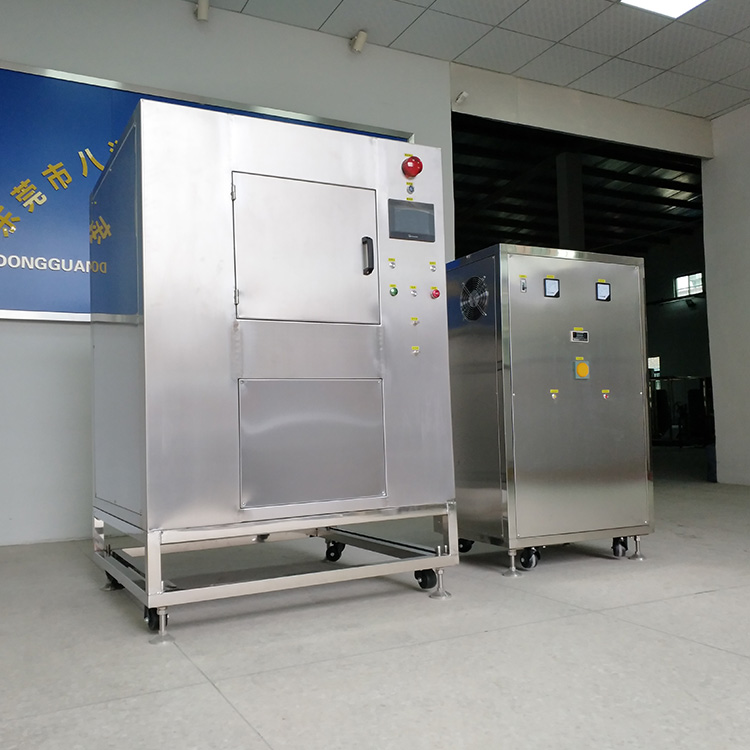The operating principle of a plasma deburring and polishing machines is to generate plasma in a gas, which then reacts chemically with the material surface, producing high-temperature, high-energy ion beams that polish the material surface. This innovative metal surface treatment process typically affects only the molecular layer of the workpiece where the plasma reacts; the spacing between atoms in the molecule is generally 0.1-0.3 nanometers, and the processing depth is 0.3-4.5 nanometers. After polishing, the surface roughness of the workpiece is within 1 micron. Therefore, the plasma chemically activates the workpiece surface, removing molecular contamination layers and cross-linking surface chemicals. Post-polishing product characteristics include reduced roughness, improved smoothness, increased precision, hardness, and wear resistance, as well as reduced notch sensitivity and a smoother, more orderly appearance. The coefficient of friction decreases, and wear is reduced.
Plasma deburring and polishing machines are suitable for the grinding and polishing of metal workpieces such as gold, silver, copper, aluminum, zinc, magnesium, iron, and stainless steel. The polisher has stable performance and good polishing results. Plasma polishing technology breaks through traditional manual polishing and high-pollution electrochemical polishing methods, eliminating both physically demanding and dirty manual labor and the use of chemicals that are harmful to the environment and human health, and can meet high-polishing and de-burring quality requirements that are difficult to achieve with traditional methods, especially for complex shapes, high precision, and difficult-to-polish and de-burr workpieces. Additionally, it has the advantages of fast polishing and deburring speed and low production costs.
Plasma polishing is utilized in precision hardware to meet stringent requirements for internal burr removal and achieving a mirror finish on surfaces, particularly with titanium and stainless steel materials. Post-polishing, surfaces exhibit enhanced corrosion resistance, effectively preventing oxidation. This technology addresses surface challenges that are difficult to manage manually.
Our environmentally-friendly electrochemical polishing machines have been significantly improved to address shortcomings in the current market, such as harsh operating environments, outdated mechanical designs, incomplete functionalities, high chemical consumption, cumbersome operation, and difficulty in sustaining production. These enhancements encompass power supply, mechanical structure, automated controls, and chemical performance, ensuring better alignment with customer needs.
Plasma polishing technology is based on the diffraction effect of plasma to achieve polishing. By dissolving electrolytes in water and applying direct current, a stable vapor gas layer forms on the surface of the workpiece. This layer separates the treated surface from the electrolyte aqueous solution, leading to intense plasma chemical and electrochemical reactions between the surface and the vapor. This process results in surface cathodic oxidation and simultaneous chemical erosion of the oxide layer, achieving a polishing effect when oxidation and erosion rates are balanced. Surface reflectivity and smoothness increase as a result. The thinnest oxide layer, which is sufficient to resist erosion, exhibits the highest reflectivity. Microscopic uneven areas have the thinnest oxide layers, where erosion occurs predominantly on protrusions. Additionally, applying sufficiently high voltage to the polished surface generates high electric field intensity among the gas layer, vapor, and electrolyte, reinforcing this effect in microscopic unevenness. These combined actions flatten micro-protrusions on the surface, achieving polishing and deburring effects.
Plasma polishing is particularly effective for workpieces with complex shapes and numerous crevices, often achieving desired polishing effects within 1-2 minutes. Depending on size and shape, dozens to hundreds of workpieces can be processed simultaneously, highlighting its efficiency. Minimal manpower is required—typically 1-2 personnel per machine. The neutral salt electrolyte used contains no harmful substances such as acids, alkalis, phosphorus, or chromium. Post-polishing wastewater can be discharged directly or undergo simple treatment (e.g., precipitation) with low costs for reagents and wastewater treatment.
Plasma Polishing Equipment Characteristics:
1. Low wear and high flatness of polished surfaces;
2. Enhanced production efficiency and reduced production costs: Easily handles burrs inside holes and surface polishing issues, with polishing times of a few minutes, significantly reducing manual labor time;
3. Fully automatic control and easy operation: After training, ordinary personnel can operate normally within 1-2 days;
4. Safe and stable, with simple maintenance: Features protective sensors to prevent accidents, designed for human-centricity, making it easy for repair and inspection;
5. Exceptional uniformity of polishing, ensuring consistent mirror-like finishes for each piece and batch, unaffected by manual skill variations.
Hand Polishing, Electrolytic Polishing, Mechanical Polishing, and Plasma Polishing, respectively, can achieve what kind of mirror-like polishing results?
1. Hand polishing can achieve a mirror finish, but it physically damages the surface, reducing corrosion resistance, specifically affecting smoke test performance.
2. Electrolytic polishing can achieve a mirror finish, but it is highly polluting and not favored by major manufacturers.
3. Mechanical polishing can achieve a mirror finish. We have tested with sanding wheels, and although it achieves a mirror finish, some areas have scratches. Method: Use a buffing wheel to remove scratches.
4. Plasma polishing can achieve a mirror finish, using a neutral conductive solution that meets environmental requirements. Precision grinding and sandblasting processes can achieve a mirror finish, but suitable plasma deburring and polishing machines is not easily available on the market, but we can customize polishing equipment to meet your needs.




